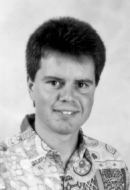
Michael E. Caspersen is currently employed at Centre for Object Technology, Department of Computer Science, University of Aarhus, where he works in a research project on architecture of embedded systems.
He earned his M.Sc. in computer science from the University of Aarhus (1987) and has been employed as lecturer at Aarhus Business College, School of Informatics from 1986 to 1998.
His professional interests include object technology, programming languages, programming methodology and formal methods.
He has worked as a consultant and held a large number of industrial courses on object technology for major danish IT companies, including Landbrugets Rådgivningscenter, Provinsbanken, Modulex, Den Danske Bank, Tele Danmark, LEC (Landbrugets Edb-Center), Datrix ICL, Tandem Computers, Crisplant, CCI-Europe, Bang & Olufsen, Danfoss, Systematic Software Engineering, OMT Consult, Ericsson Diax and Mjølner Informatik.
In research communities it is now well-accepted that the object paradigm provides a good foundation for the challenges of concurrent and distributed computing. For practitioners, however, it is not without problems to combine the concepts of processes and objects. A major reason for this is that the pre-dominant object-oriented programming language in industry, C++, does not support concurrency.
In this talk we present a simple and powerful approach to extending C++ with constructs for concurrent programming. We discuss the design, application, and implementation of a framework that supports standard concurrency constructs and, contrary to what is suggested in several books on object-oriented modeling techniques for real-time systems, we demonstrate that it is possible to integrate the notions of object and process and maintain a smooth --virtually non-existing-- transition from modeling to implementation.
The framework has been used at Bang & Olufsen, a major danish manufacturer of audio and video equipment, to develop software for a CD player; we illustrate the strength of the approach with examples from this project. As a pleasant side gain, the framework approach results in a considerable reduction of the code size of more than 50% compared to earlier versions of the system.